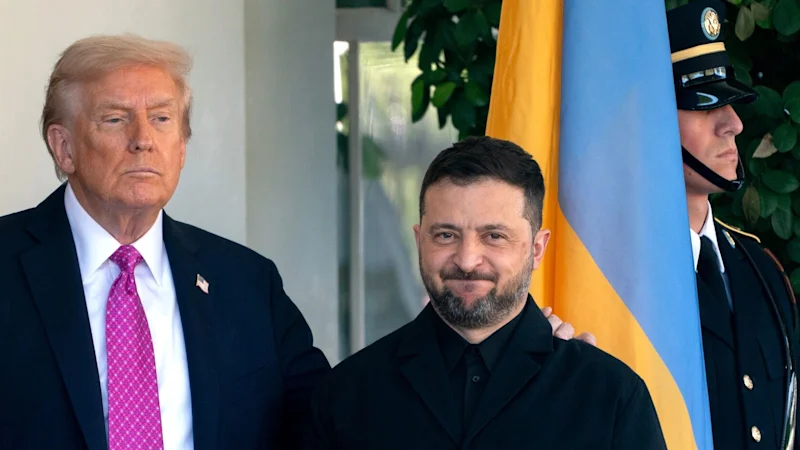
The size of the Ukrainian Armed Forces will be limited to 600,000 personnel – roughly half what they are today. There is no equivalent restriction on Russia. This is another win for Putin by weakening his target over the long-term.
Loading
These terms would not mark a total victory for Putin. Remember that his goal in February 2022, when Russian tanks came so close to Kyiv, was to turn Ukraine into a vassal state. He sought a rapid surrender and was met with resistance instead.
One of the terms even seems to require Russian to pay, in a small way, for what it has done. It says that $US100 billion in frozen Russian assets will be invested in efforts to rebuild Ukraine.
This element is also typical of Trump and his dealmaking ways. He wants the US to gain 50 per cent of the profits from the investment of the $US100 billion. He also seeks US profits from the extraction of Ukrainian minerals, but there is no assurance about American investment.
Trump offers a security guarantee to Ukraine, but it comes at a cost. “The US will receive compensation for the guarantee,” says the draft document widely circulated in the media. There will be no NATO troops on Ukrainian soil and NATO aircraft must be based in Poland, not Ukraine.
Another item is a longstanding Putin demand: Ukraine cannot join NATO. It would, however, be free to join the European Union.
European leaders are resisting the plan for the logical reason that giving so many concessions to Putin will only encourage him to use war in the years to come.Credit: AP
Trump has given ground to Putin on every major Russian demand. The US president often complains about the Russian leader, saying he will talk about peace during the day while sending missiles into Ukraine each night, but he does not have the stomach for a long conflict.
The terms include ending the economic sanctions against Russia, presumably including the bans on Russian oil companies Trump announced last month. Trump will do what it takes to end the war. He is not greatly concerned about the sovereignty or security of Ukraine over the years or decades to come.
European leaders are resisting the plan for the logical reason that giving so many concessions to Putin will only encourage him to use war, and the threat of war, in the years to come.
There can be no assurance of value from Putin after his long list of conflicts in eastern Europe (from Georgia and Moldova to Ukraine) and his increasing use of hybrid war (arson, cyber, criminal plots and assassinations) against liberal democracies.
Even Europe, however, has to weigh up the awful cost of continued war against the benefits of a peace, as fragile as that peace may be.
Zelensky, also, has to consider the 28 points as a way to gain a negotiated settlement. His response on Friday was to demonstrate that he was considering the plan. This is not the easiest option for a leader who has rallied his country to fight a war without rest.
“Ukrainians, more than anyone else in the world, want this war to end, the killings to stop, and a dignified peace to be achieved,” he said.
Zelensky is talking to NATO and European leaders ahead of a conversation with Trump, clearly exploring ways to amend the draft terms into something more acceptable. He does not reject the plan, saying: “We are ready to work swiftly and constructively to ensure it succeeds.”
There is no doubt that Putin wins if the 28 points are imposed without change. The draft plan is a capitulation by Trump to Putin and is likely to be condemned for rewarding war.
This seems unfair. And, in fact, it is unfair. But the draft peace plan cannot be dismissed when there is a chance of turning it into a workable agreement to end the war. This is true even if Putin emerges from the negotiation with something he wants – and even if he emerges with a smile.
The fact is that very few peace deals can leave one side triumphant and another demolished. History shows that most deals work when the terms offer something to both sides.
The humiliation of Germany in 1919 did not deliver the lasting peace the world wanted. The stalemate that ended the Korean War was fragile but was followed by recovery and prosperity for South Korea.
Even the devastation of Germany and Japan in 1945, which remains unparalleled, was followed by reconstruction for the defeated nations rather than more humiliation.
Without a conclusive military outcome, every peace deal is a compromise. And the compromise at the end of a war requires incredibly painful concessions because the fighting hardens a nation against its enemy. This makes it easy to shout down those who will argue for a rational but unpalatable peace.
Can Russia lose this war? Possibly. Russia is exposed to economic defeat as long as trade sanctions starve Moscow of money and slow its industrial production. Could Russia face an overwhelming military defeat? Probably not, as long as Putin can wield nuclear weapons.
The war in Ukraine could continue for years while liberal democracies wait for a popular revolt against Putin that echoes the end of the Cold War.
Europe will have an interest in maintaining economic pressure on Russia to weaken Putin even if there is a ceasefire. A handshake on Ukraine will not spare NATO members from having to ramp up their defences.
This draft peace deal is easy to condemn because it is so generous to Putin – and because it so brazenly favours its author. Trump seems to have only a passing interest in Ukraine’s long-term security while he seeks to extract American profits from its reconstruction and, no doubt, campaigns for a Nobel Peace Prize.
As a draft, however, this plan cannot be rejected. If there is a path to peace, it will have to be explored, dark as that path may be.
Get a note directly from our foreign correspondents on what’s making headlines around the world. Sign up for our weekly What in the World newsletter.





